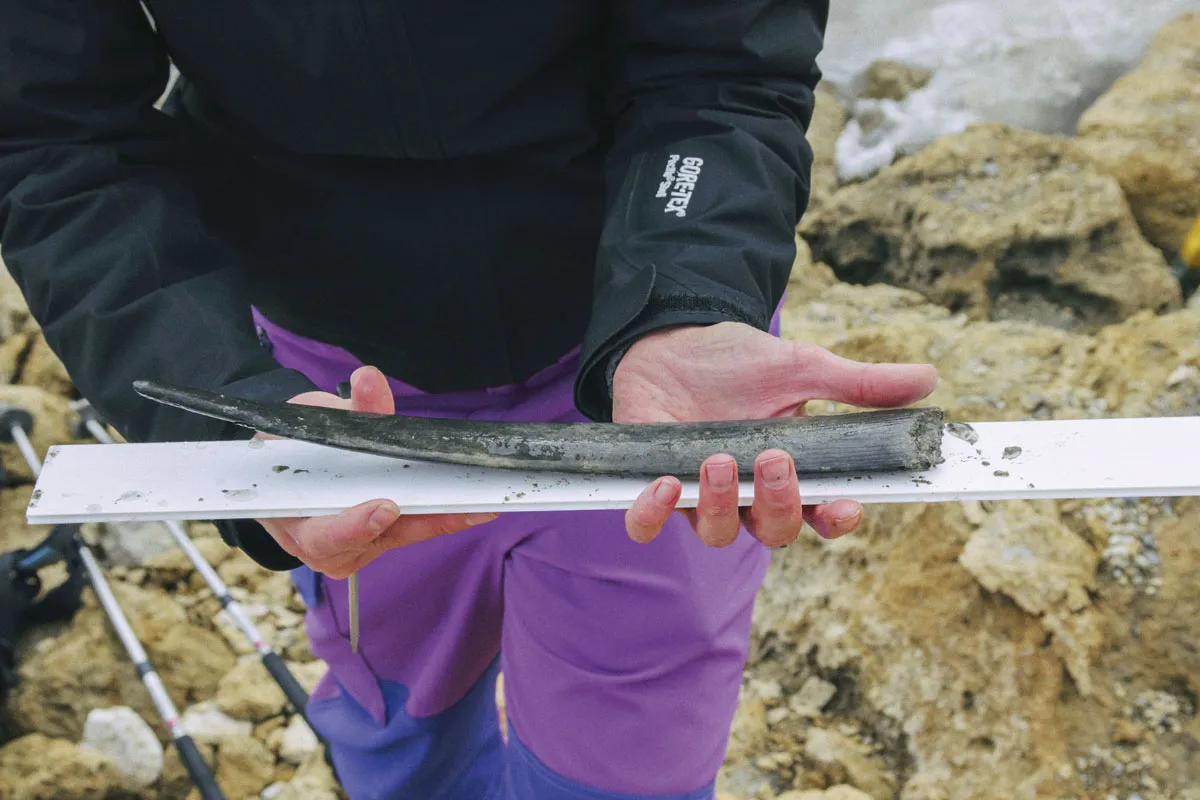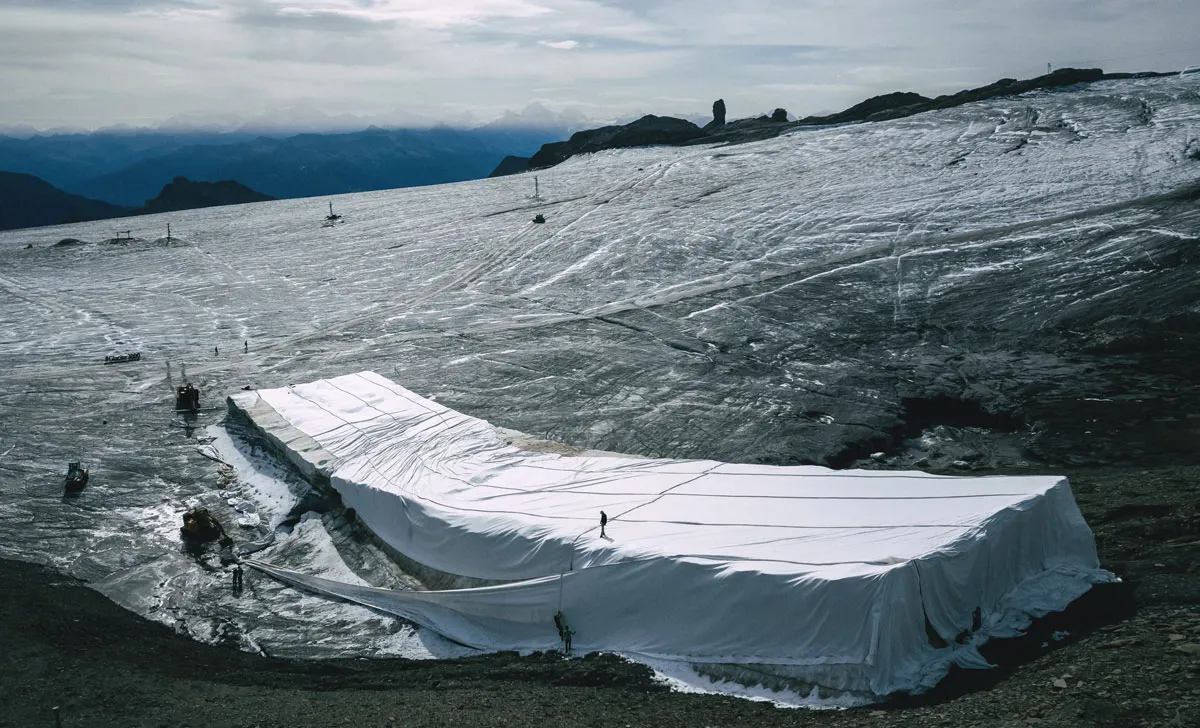On top of a nearby rock, a marmot perches, rotund from a summer of feasting. Cowbells chime in the green pasture below. The path ahead is blocked by a stubborn herd of sheep. As I approach, they scurry up the rocky cliff.
Balancing stone to stone, I cross a small stream, before zigzagging up the mountainside. The higher I go, the harder it is to breathe, the altitude and heavy backpack weighing me down. I’m now past the tree line. The ground is barren, except for some lichen clinging to the rocky ground.
A vulture circles above. Its vast wings outstretched, swooping in for a closer look, before soaring upwards on a thermal and disappearing from view into a cloud. Another looms out of the white-grey sky, then another. Soon five are overhead, eyeing up the carcass of a dead sheep lying beside the path.
Not far ahead is our destination – the Lötschepass in the Swiss Alps. Despite the pass being at an altitude of 2,690 metres, it was historically a trade route between the valleys far below.
“Colleagues once found the remains of a medieval cow skeleton at the top of the pass,” says archaeologist Regula Gubler. “Radiocarbon dating revealed the cow was from the 15th or 16th Century. There are also written sources from that time showing people brought cattle across the pass to market.”
The cow skull was discovered around a decade ago by a team of archaeologists surveying the remains of a permanent ice patch up on the pass. Since then, the site has yielded all sorts of treasures.
“Our best finds have been a whole assemblage of early Bronze Age things, from about 2000 BC,” says Gubler. “There was a box made out of wood, two bows, fragments of arrow shafts and three flint arrowheads. Inside the box were cereal grains, which tells us what those people took along to cook. It seems like someone left half their equipment up here. The artefacts were really well made – those people knew how to use raw materials to create leather straps and bindings, for example.”

Melting glaciers and ice patches around the world have created an opportunity for archaeologists to dramatically expand their understanding of how mountain life has changed through the millennia. One intriguing find revealed by melting ice was Ötzi ‘the Iceman’ who lived more than 5,000 years ago.
But archaeologists recognise such discoveries are bittersweet. Since Gubler has been involved in the project, the ice patch has dwindled. Now, in the summer months, it is just a small pool of water.
“As an archaeologist it is incredibly exciting for me to find such artefacts,” says Gubler. “But it’s also very sad. I’d rather the artefacts remained covered by snow and ice.”
Glaciers move downhill, albeit extremely slowly. So whatever artefacts go into the glacier get spat out the other end. Ice patches, on the other hand, are stationary, so artefacts can be trapped in the ice for thousands of years. But as the artefacts emerge from the ice, the race is on to save the ancient treasures before they decay in the open air. Gubler is the only archaeologist working on such sites in this region of Switzerland.
All around the world, archaeologists are facing the same huge challenge of surveying and cataloguing sites in time, because thawing is occurring too fast for their limited resources.
The race is on
Climate change is to blame for the rapid melting of glaciers, ice patches and permafrost. The rate of melting in the Alps is faster than in some parts of the world, because the level of warming at higher latitudes is greater than closer to the equator.
“In this year alone, we’ve lost about 6 per cent of the total glacier ice volume that is still present in Switzerland,” says Matthias Huss, a glaciologist and head of Glamos, an organisation that monitors glaciers in Switzerland. “That is much more than ever before. In the last decade, we’ve typically seen 2 per cent ice volume lost per year. This year [2022] is three times more than the average of the last 10 years.”
Read more:
- How Antarctic ice can help us travel back in time
- Meet the scientists going to extreme lengths to study climate change
- Why are some icebergs green?
Glaciologists put 2022’s dramatic ice loss down to a combination of three factors: minimal snowfall, heat waves and Saharan dust. With little snowfall during winter, there was a thinner protective layer than usual by the start of the summer, so the snow melted sooner, exposing the ice, and so ice loss started earlier in the season. Dust blown across the Mediterranean from the Sahara Desert between March and May made Alpine snow dirty, so it absorbed more solar radiation and melted faster. The final nail in the coffin was the scorching heatwave in the Alps from May through to the beginning of September.
The rate of melting across the Alps is so severe that the Glamos researchers are starting to abandon some measuring stations. The station at Corvatsch has been shut down, as there remains little ice on the glacier left to measure. Glaciologists predict that 95 per cent of the 4,000 or so glaciers dotted throughout the Alps could disappear by the end of this century.
“2022 was worse than we expected,” says Huss. “For some time, climate models have been predicting extreme weather would become more frequent, and our glacier models have shown that such extreme melt rates are possible. But we wouldn’t have expected to see such extreme events yet. The future has already become reality.”

Saving glaciers and lives
Globally, melting glaciers also threaten the lives of communities living nearby. Glaciers are like ‘water towers’ – they store snow that falls during the winter months and then gradually release it through the summer, providing drinking water, irrigation for crops, and a cooling mechanism for power stations. Melting ice also impacts the local tourist industry.
For example, the route to the summit of Mont Blanc is becoming more treacherous earlier in the season because of the increased risk of rock falls. In July 2022, a glacial ice shelf in Italy collapsed, killing 11 hikers. Severe glacial melt in the Himalayas exacerbated the deadly floods in Pakistan.
Read more:
- These ancient stone weapons may link the ice age peoples of North America and Northeast Asia
- Rapid Ice Age retreat of Antarctic ice gives stark climate change warning
Extreme weather conditions need extreme measures. There has been talk of large-scale geoengineering projects to help save the glaciers.
“Geoengineering projects work at a local scale, but they’ll never work at the glacial scale,” says Huss. “One could put some white blankets over the ice below a ski run to retain economic activities. But these technologies won’t ever be able to save one entire glacier, and even less all the glaciers in the Alps or worldwide.
“We can save some of the glaciers in the Alps by reducing carbon emissions, it has been computed that about one-third of the ice volume that we have today in the Alps can be saved if the Paris Agreement is fully implemented. But this is pretty ambitious. Even then, we will lose most of the glaciers in the Alps – that is assuming we only see limited further temperature rise from today.”
The goal of the Paris Agreement is to limit global warming to well below 2°C, ideally 1.5°C, compared to pre-industrial levels. Whether that can be achieved is a challenge for us all. Even if the Paris Agreement is implemented, temperatures are expected to rise for several decades before they stabilise in the second half of the century.

Ticking time bomb
Back at the Lötschepass, I climb slightly higher to get a good view of a nearby glacier. Relatively small in size, its ice sheet snakes down the valley, covered by rocks and scree. The most striking feature is the head of the glacier. An arch is carved into the rock face. A decade ago, this arch marked the surface of the glacier. The surface now lies 10 metres below. It shows the glacier is not just shrinking in length, but also in depth – rapidly.
The still mountain air is broken by a shout. I head back down to the archaeological site.
“Birch bark! We’ve found birch bark!” yells Gubler triumphantly. “This was on my colleague’s wishlist. She did her PhD on methods of conserving birch bark. I once found a whole bag made of birch bark, and she asked me to find her another!”
Buoyed on by the birch bark discovery, I scour the silt and rocks around the pond. I’m in luck. A vertebra – too large to be from a human. Gubler says that it’s part of the medieval cow skeleton. I’m tasked with carefully bagging and cataloguing my find, so it can be taken down the mountain to the laboratory for analysis, along with the other discoveries.
Who knows what other treasures lie nearby, emerging from the melting mountain landscapes, waiting to be discovered. But as climate change kicks in, at the Lötschepass site, and all around the Alps, time is rapidly running out.
Could melting permafrost release the next pandemic?
As its name suggests, permafrost is permanently frozen ground. It covers one-quarter of the northern hemisphere. Rising global temperatures are causing permafrost to melt, raising concerns that the 1.5 trillion tonnes of carbon trapped in frozen ground will be released into the atmosphere. But now a new concern is also rearing its head – the release of contagious bugs.
Recent research published in the Proceedings Of The Royal Society B in October 2022 revealed that the risk of viruses being transferred to new hosts was more likely in areas where there were large amounts of glacial meltwater.
In 2021, researchers at Ohio State University in the US discovered 15,000-year-old genetic material from 28 new viruses taken from ice samples from the Tibetan plateau in China. And back in 2014, under lab conditions, scientists at the National Centre for Scientific Research in France revived a virus taken from Siberian permafrost, making it infectious again after 30,000 years of being locked away in the frozen ground.
As the climate warms, melting permafrost does increase the risk of deadly bugs being released. It’s a big leap to claim this melting could cause the next pandemic. But there are concerns that ancient viruses and bacteria could come into contact with new hosts that didn’t exist years ago when they were initially locked away in the frozen ground.
Read more about glaciers: